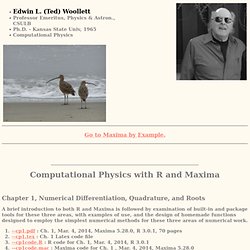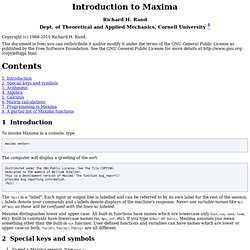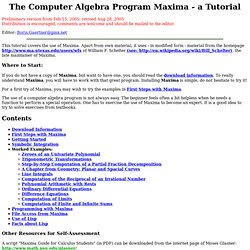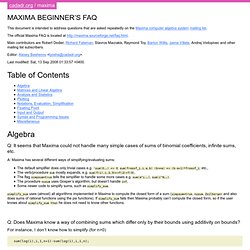

Documentation // Maxima CAS. Edwin L. (Ted) Woollett Web Page. Go to Maxima by Example.

Computational Physics with R and Maxima Chapter 1, Numerical Differentiation, Quadrature, and Roots A brief introduction to both R and Maxima is followed by examination of built-in and package tools for these three areas, with examples of use, and the design of homemade functions designed to employ the simplest numerical methods for these three areas of numerical work. A 10 minute tutorial for solving Math problems with Maxima. Posted by Antonio Cangiano in Essential Math, Software on June 4th, 2007 | 132 responses About 50,000 people read my article 3 awesome free Math programs.

Chances are that at least some of them downloaded and installed Maxima. If you are one of them but are not acquainted with CAS (Computer Algebra System) software, Maxima may appear very complicated and difficult to use, even for the resolution of simple high school or calculus problems. This doesn’t have to be the case though, whether you are looking for more math resources to use in your career or a student in an online bachelor’s degree in math looking for homework help, Maxima is very friendly and this 10 minute tutorial will get you started right away.
Once you’ve got the first steps down, you can always look up the specific function that you need, or learn more from Maxima’s official manual. Maxima as a calculator (%i1) 9+7; (%o1) (%i2) -17*19; (%o2) (%i3) 10/2; (%o3) (%i4) % - 10; (%o4) (%i5) %o1 * 3; (%o5) float(1/3); => sqrt(81); => Introduction to Maxima. Richard H.

Rand Dept. of Theoretical and Applied Mechanics, Cornell University 1 Copyright (c) 1988-2010 Richard H. Rand. This document is free; you can redistribute it and/or modify it under the terms of the GNU General Public License as published by the Free Software Foundation. See the GNU General Public License for more details at 1 Introduction 2 Special keys and symbols 3 Arithmetic 4 Algebra 5 Calculus 6 Matrix calculations 7 Programming in Maxima 8 A partial list of Maxima functions 1 Introduction To invoke Maxima in a console, type maxima <enter> The computer will display a greeting of the sort: Distributed under the GNU Public License.
The (%i1) is a "label". 2 Special keys and symbols To end a Maxima session, type quit();. 3 Arithmetic The common arithmetic operations are addition subtraction scalar multiplication division or ** exponentiation matrix multiplication. Maxima Tutorial. Preliminary version from Feb 15, 2005; revised Aug 28, 2005.

Distribution is encouraged, comments are welcome and should be mailed to the editor. Editor: Boris.Gaertner@gmx.net This tutorial covers the use of Maxima. Apart from own material, it uses - in modified form - material from the homepage of William F. Schelter (see: the late maintainer of Maxima. Where to Start: If you do not have a copy of Maxima, but want to have one, you should read the download information.
For a first try of Maxima, you may wish to try the examples in First Steps with Maxima. The use of a computer algebra program is not always easy. Other Resources for Self-Assessment. Maxima Beginner’s FAQ. Cadadr.org / maxima This document is intended to address questions that are asked repeatedly on the Maxima computer algebra system mailing list.

The official Maxima FAQ is located at Main contributors are Robert Dodier, Richard Fateman, Stavros Macrakis, Raymond Toy, Barton Willis, Jaime Villate, Andrej Vodopivec and other mailing list subscribers. Editor: Alexey Beshenov <lyosha@cadadr.org>. Last modified: Sat, 13 Sep 2008 01:33:57 +0400.
Table of Contents Algebra Q: It seems that Maxima could not handle many simple cases of sums of binomial coefficients, infinite sums, etc. A: Maxima has several different ways of simplifying/evaluating sums: The default simplifier does only trivial cases e.g. Simplify_sum uses (almost) all algorithms implemented in Maxima to compute the closed form of a sum (simpsum=true, nusum, Zeilberger and also does sums of rational functions using the psi functions).
Q: Does Maxima know a way of combining sums which differ only by their bounds using additivity on bounds? Index of /maxima/book.